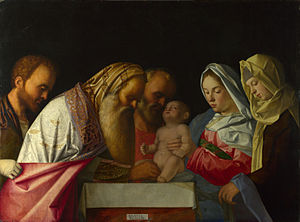Circumcision (Bellini)

|
| The circumcision |
|---|
| Giovanni Bellini , around 1500 |
| Oil on canvas |
| 75 × 102 cm |
| National Gallery, London |
Circumcision is an oil painting that was created around 1500 in the school of the Italian painter Giovanni Bellini . It is exhibited in the National Gallery in London, its dimensions are 75 × 102 cm. The scene shows Jesus being circumcised eight days after he was born ( Luke 2:21 ). The dark background of the painting does not reveal the exact location. The peculiarity of this iconography is that the child does not sit on the Sandaq's knee as usual .
Bellini shows the baby Jesus being circumcised with clenched fists, which seems to demonstrate his determination to courageously endure this bloody operation.
description
The painting shows a group of people standing behind an altar. Men and women stand separately. On the left are the high priest and a bearded man with white gloves holding the cape of the so-called mohel , the top of which reflects the light. The high priest bends over the table and his long beard falls between his hands, which are on the groin of the baby Jesus. His gaze is focused on the operation being performed. With his fingers - the knife is out of sight - he cuts the foreskin of the baby. Between him and the baby Jesus stands Joseph, who wears a red robe, a beard and short hair. In the middle of the scene, the naked child is resting on a blue pillow. His head is tilted back, his limbs are shown rounded. On the right side there are two women at the table: One is the Virgin Mary who is holding her child. She wears a light blue scarf on her head, her dress is red and her belt is green with red stripes. She covers her shoulders with a blue coat. The person on the far right is a young woman with a yellow headdress who may be the ba'al brit who has been present at the ceremony since the 15th century (similar to the Christian godmother). In Venice, her yellow headdress pointed to the Ashkenazi Jewish community. Her robes embroidered with pearls show a high social status. During the Renaissance, pearls symbolized the virginity of Mary and the virgin birth of Jesus. In the foreground, an inscription shows the name of the artist "Ioannes Bellinus" in capital letters.
Individual evidence
- ^ A b Yaron Harel, Mauro Perani: The Jews in Italy: Their Contribution to the Development and Diffusion of Jewish Heritage . Academic Studies Press, 2019, ISBN 978-1-64469-258-5 ( google.de [accessed July 20, 2020]).
- ↑ Jan-Heiner Tück : The circumcision of Jesus: What it means to Jews and Christians today . Verlag Herder, 2020, ISBN 978-3-451-83643-5 , pp. 245 ( google.de [accessed on July 20, 2020]).